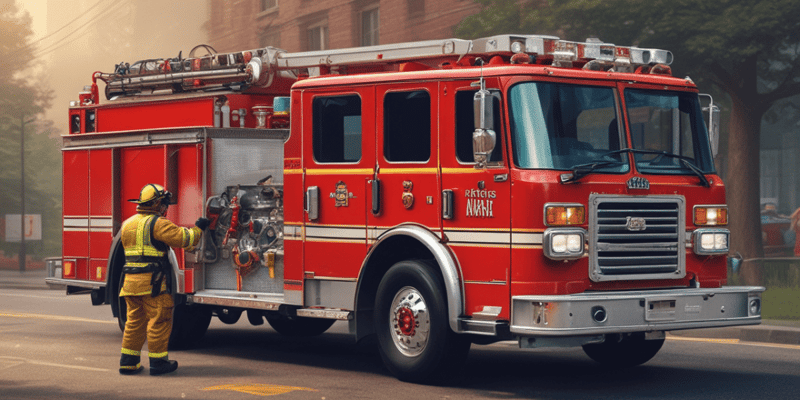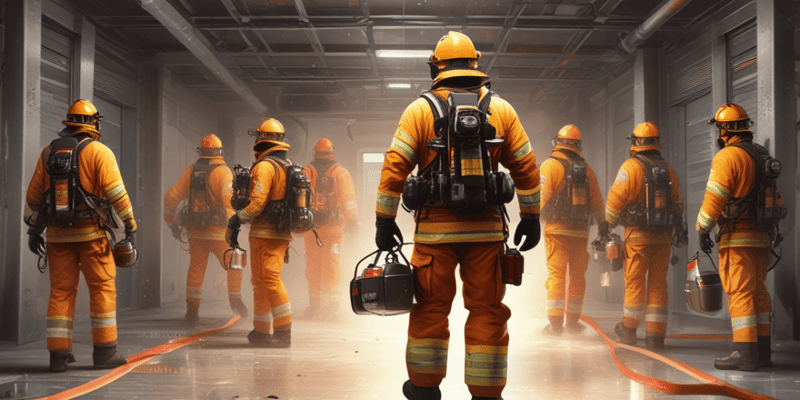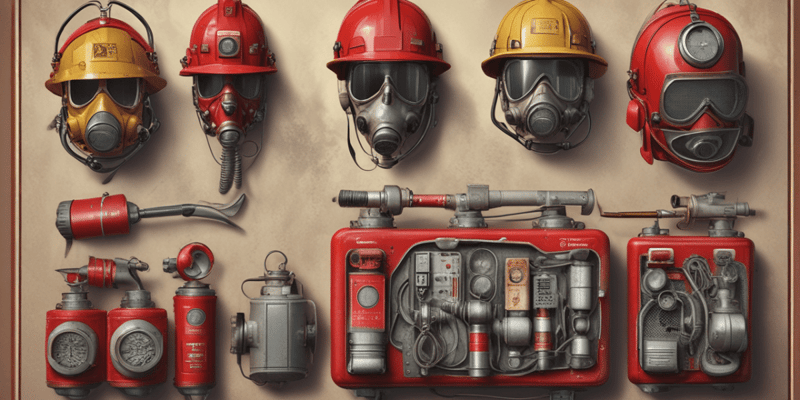20 Questions
What is one of the primary roles of ventilation in firefighting?
To increase the speed at which heat and smoke can escape the building
What is the greatest firefighting problem according to the text?
Fire travel by convection
In the context of fire buildings, what does 'mushrooming' refer to?
The horizontal escape of hot gases and smoke under a roof
Why should there be at least one ventilation opening of adequate size made at the top of the building during a fire?
To prevent the accumulation of combustion products under the roof
What is the primary objective of ventilation during firefighting operations?
To save lives
What can improper ventilation techniques lead to?
Increased fire spread
Which of the following is NOT a benefit of proper ventilation?
Ensuring fire engines reach the fire faster
What is the term for how hot air and smoke fill a building from the top down when vertical and horizontal pathways are blocked?
Product buildup
What aspect of fire fighting does ventilation NOT directly aid in accomplishing?
Decreasing fireground efficiency
How do fire fighters prevent secondary fires from igniting in a burning building?
By making an opening through which the products of combustion can escape
What is a primary reason for creating ventilation openings at the top of a building during a fire?
To reduce the accumulation of products of combustion
Which of the following best describes 'mushrooming' in firefighting?
Accumulation of hot gases and smoke under the roof causing them to escape horizontally
What is a significant risk associated with improper ventilation techniques in firefighting?
Enhanced spread of fire through the building
How does proper ventilation aid in preventing the occurrence of a flashover?
By allowing heat and combustion products to escape
Why is coordination between ladder companies and engine companies crucial during fire attacks?
To synchronize ventilation and extinguishing efforts
What challenge occurs when both vertical and horizontal pathways in a building are blocked during a fire?
Accumulation of combustion products filling the building from the top down
In firefighting, what is the general rule behind all ventilation operations?
To ensure all accumulations of heat and combustion products leave the building by natural convection
Which action is essential to minimize the risk of secondary fires in a burning building?
Reducing the accumulation of hot air and combustion products under the roof
How does proper ventilation extend the time available for search and rescue operations?
By reducing heat and smoke, allowing firefighters to operate more safely
Which of the following best describes the sequence of ventilation operations?
Simultaneous openings at the fire floor and the top of the building
Study Notes
Benefits of Ventilation
- Proper ventilation in firefighting increases visibility, allows firefighters to reach the seat of the fire faster, reduces the danger from heat and smoke, and helps prevent flashover and backdraft explosions.
- Ventilation directly aids in saving lives, which is the primary objective of firefighting operations.
Importance of Coordination
- Ladder companies and engine companies need to work together in a coordinated effort for a successful fire attack.
Ventilation Principle
- Ventilation is the process of making openings in a fire building or exposure to allow heat and the products of combustion to leave the building.
Key Objectives of Ventilation
- Reducing the danger from heat and smoke to trapped occupants
- Extending the time available for fire fighters to perform search and rescue operations
- Increasing visibility for fire fighters and occupants, decreasing the danger inherent in fireground operations and increasing fireground efficiency
- Permitting quicker and easier entry and allowing fire fighters to conduct search operations and advance attack lines into the building
- Minimizing the time required to locate the seat of the fire
- Minimizing the time required by ladder crews to locate and expose areas in which the fire has extended within the building
- Decreasing or stopping the extension of fire
- Reducing the chance of flashover or backdraft explosion
Basic Principles of Fire Travel
- The greatest firefighting problem is fire travel by convection, where hot air, smoke, heated gases, and burning embers move through a building vertically and horizontally.
- If horizontal pathways are also blocked, products of combustion build up and begin to fill the building from the top down.
Accumulation of Combustion Products
- The accumulation of hot gases and smoke under a roof blocks vertical pathways, causing them to escape horizontally, leading to "mushrooming".
- To prevent secondary fires, firefighters must reduce the accumulation of combustion products under the roof by making an opening for escape.
Ventilation Techniques
- Make at least one ventilation opening of adequate size at the top of the building directly above the fire.
- Openings on the fire floor are usually made through windows and doors that lead directly from the accumulations of combustion products to the outside of the building.
- Ventilation operations should be performed simultaneously, opening the fire floor to relieve the accumulation of heat and combustion products.
Benefits of Ventilation
- Proper ventilation in firefighting increases visibility, allows firefighters to reach the seat of the fire faster, reduces the danger from heat and smoke, and helps prevent flashover and backdraft explosions.
- Ventilation directly aids in saving lives, which is the primary objective of firefighting operations.
Importance of Coordination
- Ladder companies and engine companies need to work together in a coordinated effort for a successful fire attack.
Ventilation Principle
- Ventilation is the process of making openings in a fire building or exposure to allow heat and the products of combustion to leave the building.
Key Objectives of Ventilation
- Reducing the danger from heat and smoke to trapped occupants
- Extending the time available for fire fighters to perform search and rescue operations
- Increasing visibility for fire fighters and occupants, decreasing the danger inherent in fireground operations and increasing fireground efficiency
- Permitting quicker and easier entry and allowing fire fighters to conduct search operations and advance attack lines into the building
- Minimizing the time required to locate the seat of the fire
- Minimizing the time required by ladder crews to locate and expose areas in which the fire has extended within the building
- Decreasing or stopping the extension of fire
- Reducing the chance of flashover or backdraft explosion
Basic Principles of Fire Travel
- The greatest firefighting problem is fire travel by convection, where hot air, smoke, heated gases, and burning embers move through a building vertically and horizontally.
- If horizontal pathways are also blocked, products of combustion build up and begin to fill the building from the top down.
Accumulation of Combustion Products
- The accumulation of hot gases and smoke under a roof blocks vertical pathways, causing them to escape horizontally, leading to "mushrooming".
- To prevent secondary fires, firefighters must reduce the accumulation of combustion products under the roof by making an opening for escape.
Ventilation Techniques
- Make at least one ventilation opening of adequate size at the top of the building directly above the fire.
- Openings on the fire floor are usually made through windows and doors that lead directly from the accumulations of combustion products to the outside of the building.
- Ventilation operations should be performed simultaneously, opening the fire floor to relieve the accumulation of heat and combustion products.
Learn the importance of ventilation in firefighting, its benefits, and how to use it to fight fires effectively and safely.
Make Your Own Quizzes and Flashcards
Convert your notes into interactive study material.
Get started for free



